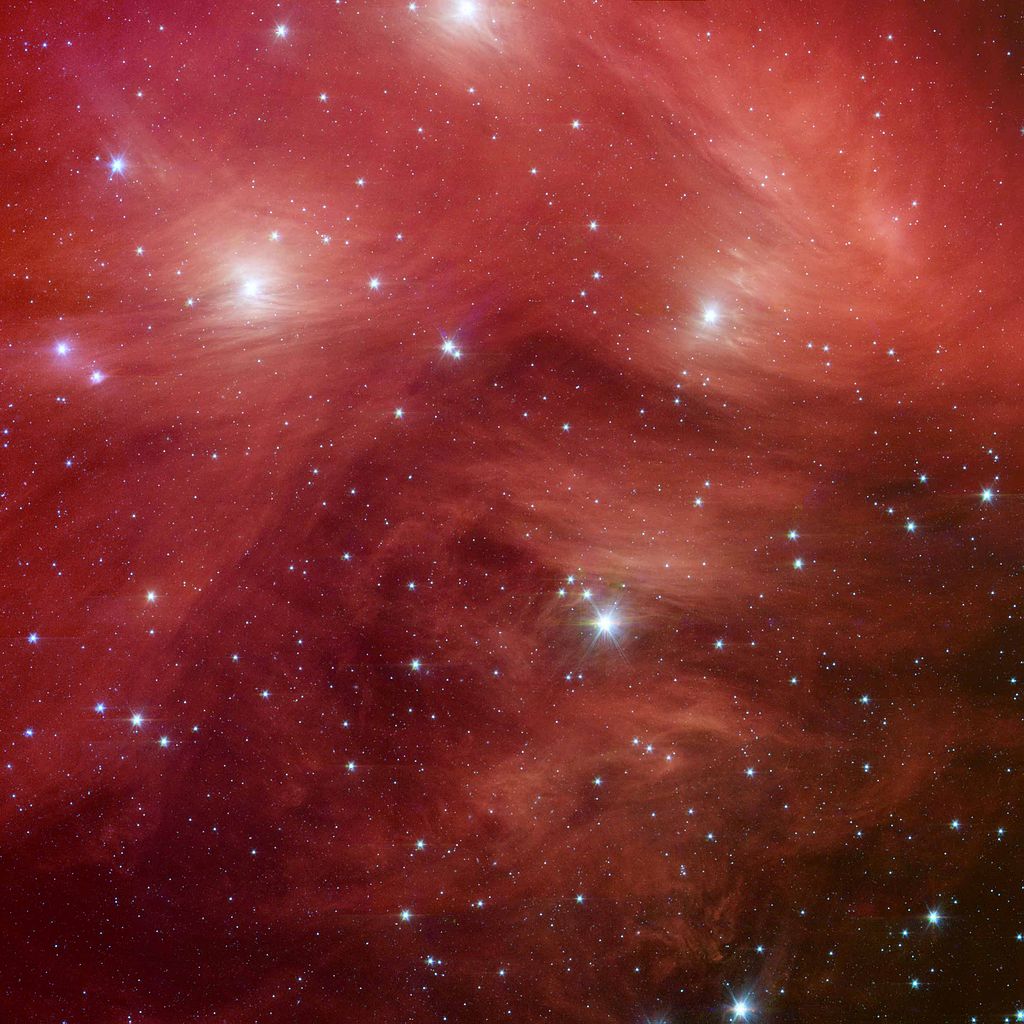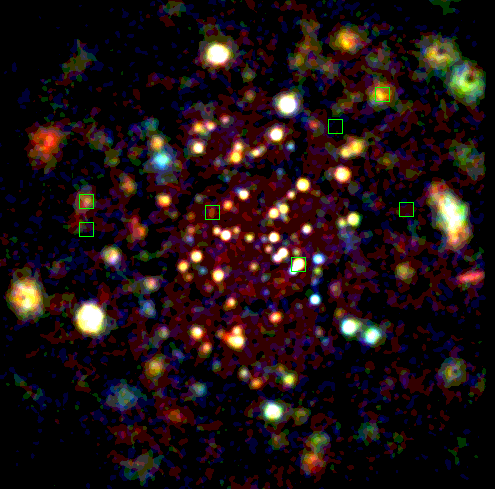Messier 45 (M45), also known as the Pleiades or Seven Sisters, is a bright open star cluster located in the constellation Taurus, the Bull. The Pleiades cluster has an apparent magnitude of 1.6 and lies at an average distance of 444 light years from Earth. The cluster is also known as Melotte 22. It does not have an NGC designation.
Messier 45 contains a number of hot, blue, extremely luminous B-type stars and is one of the nearest star clusters to Earth. It is the easiest object of its kind to see without binoculars. M45 has a core radius of 8 light years and its tidal radius extends to about 43 light years. The cluster is home to more than 1,000 confirmed members, but only a handful of these stars are visible to the naked eye. The total mass of M45 is estimated at about 800 solar masses.
The Pleiades cluster occupies an area of 110 arc minutes, about four times the apparent diameter of the full Moon. Up to 14 stars are visible without binoculars in good conditions, with clear skies and no light pollution. The best time of year to observe M45 from northern latitudes is during the winter months, when Taurus constellation rises high in the sky. Because of the cluster’s apparent size, the best way to see it is through binoculars and small or wide field telescopes. Higher magnification is only recommended for studying individual stars.
The names of the nine brightest stars in M45 are taken from Greek mythology and they represent the Pleiades, the Seven Sisters – Asterope, Electra, Merope, Maia, Celaeno, Taygeta, and Alcyone – and their parents, Pleione and Atlas.
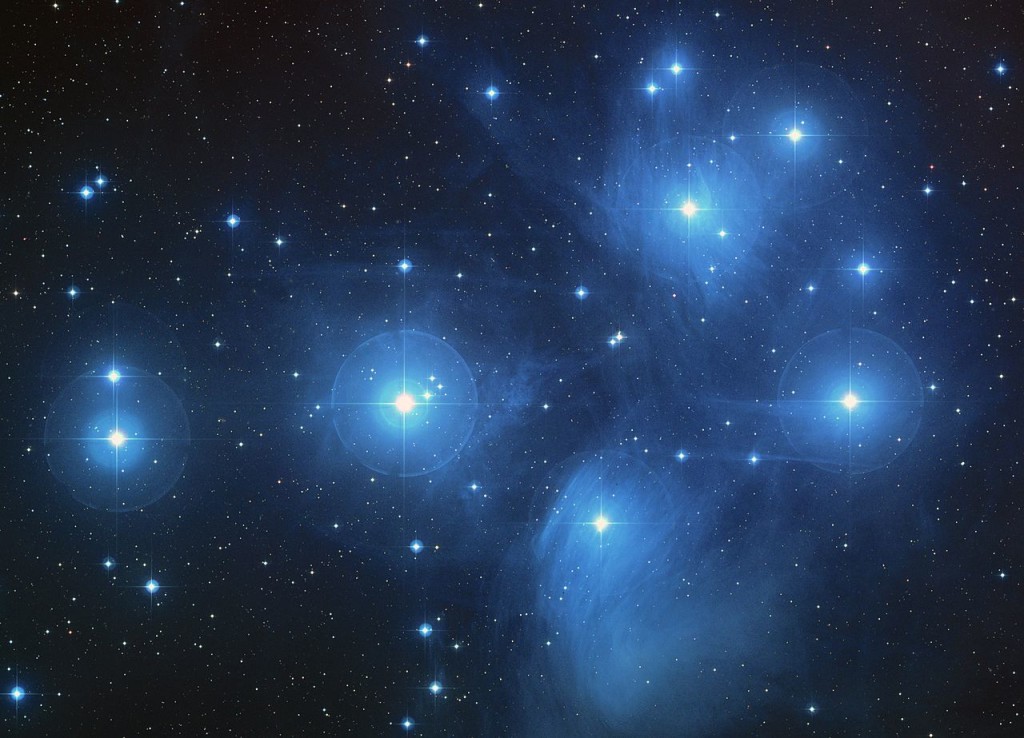
The stars in the Pleiades cluster have formed in the last 100 million years and they will stay gravitationally bound to each other for another 250 million years before the cluster disperses as a result of tidal interactions with other objects in the neighbourhood. By that point, the cluster will have moved from Taurus to Orion.
The name Pleiades is believed to be derived from the Greek plein, which means “to sail.” The beginning of the sailing season in the Mediterranean Sea coincided with the cluster’s heliacal rising, or becoming visible above the horizon after a period of invisibility. The name of the mythical sisters comes from that of their mother Pleione, an Oceanid nymph who was married to the Titan Atlas and also gave birth to the Hyades, nymphs said to bring rain, and Hyas, Hyades’ brother who was killed in a hunting accident and is said to be forever mourned by his sisters.
Messier 45 has a faint reflection nebula surrounding it, named Maia Nebula, after one of the cluster’s brightest stars. The nebula is not related to the cluster’s formation, but is merely a dust cloud through which the Pleiades stars are currently passing. Like other nebulae in the Pleiades cluster, the Maia Nebula has a different radial velocity than the cluster itself, indicating that the two are unrelated and only crossing paths by chance.
The brightest reflection nebula in M45 is the Merope Nebula, surrounding the star Merope. The nebula is also known as Tempel’s Nebula, after its discoverer, the German astronomer Wilhelm Tempel.
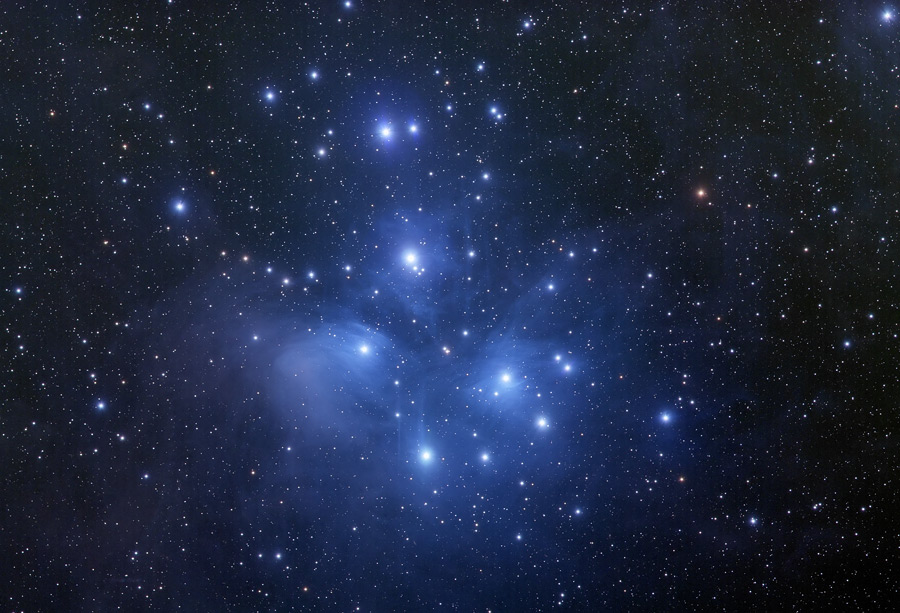
In addition to Maia and Merope, reflection nebulae have also been found around the stars Alcyone, Taygeta, Electra and Celaeno. American astronomer Edward Emerson Barnard also discovered a bright knot near Merope, which was later designated as IC 349 and nicknamed Barnard’s Merope Nebula.
Messier 45 has an estimated age of 150 million years. It does not contain extremely high-mass O-type stars or the brightest kind of B-type stars, which means that star formation in the cluster ended at least 80 million years ago.
Up to 25 percent of the stars in the Pleiades cluster are brown dwarfs, objects with less than 8 percent of the Sun’s mass, and their combined mass is less than 2 percent of the total mass of the cluster.
One of the stars in the cluster, designated HD 23514, was discovered to be surrounded by a large number of hot dust particles, also known as planetesimals, which orbit within the star’s circumstellar disk. The discovery, made with the Spitzer Space Telescope, could indicate planet formation around the star. HD 23514 is a class F6 main sequence star less than a million years old.
The cluster is home to a large number of X-ray sources, which are usually associated with stars that exploded as supernovae. X-ray sources are powered by dust and gas accelerated by objects like neutron stars or black holes.
The remaining B-type members of M45 do not have enough mass to create supernova events, but will eventually eject their outer layers to form planetary nebulae, leaving behind white dwarfs to illuminate the clouds of expelled material.
Galileo Galilei was the first astronomer to observe M45 through a telescope. He published his notes with a sketch of the cluster in a short astronomical treatise titled Sidereus Nuncius (Sidereal Messenger) in March 1610. His sketch showed 36 of the cluster’s stars.
Italian astronomer Giovanni Battista Hodierna counted 37 stars in the cluster in 1654, noting that “the first, and the most lumious of all assemblies of stars, shines in the belly of Taurus; six, or seven stars are most evident, before many others…”
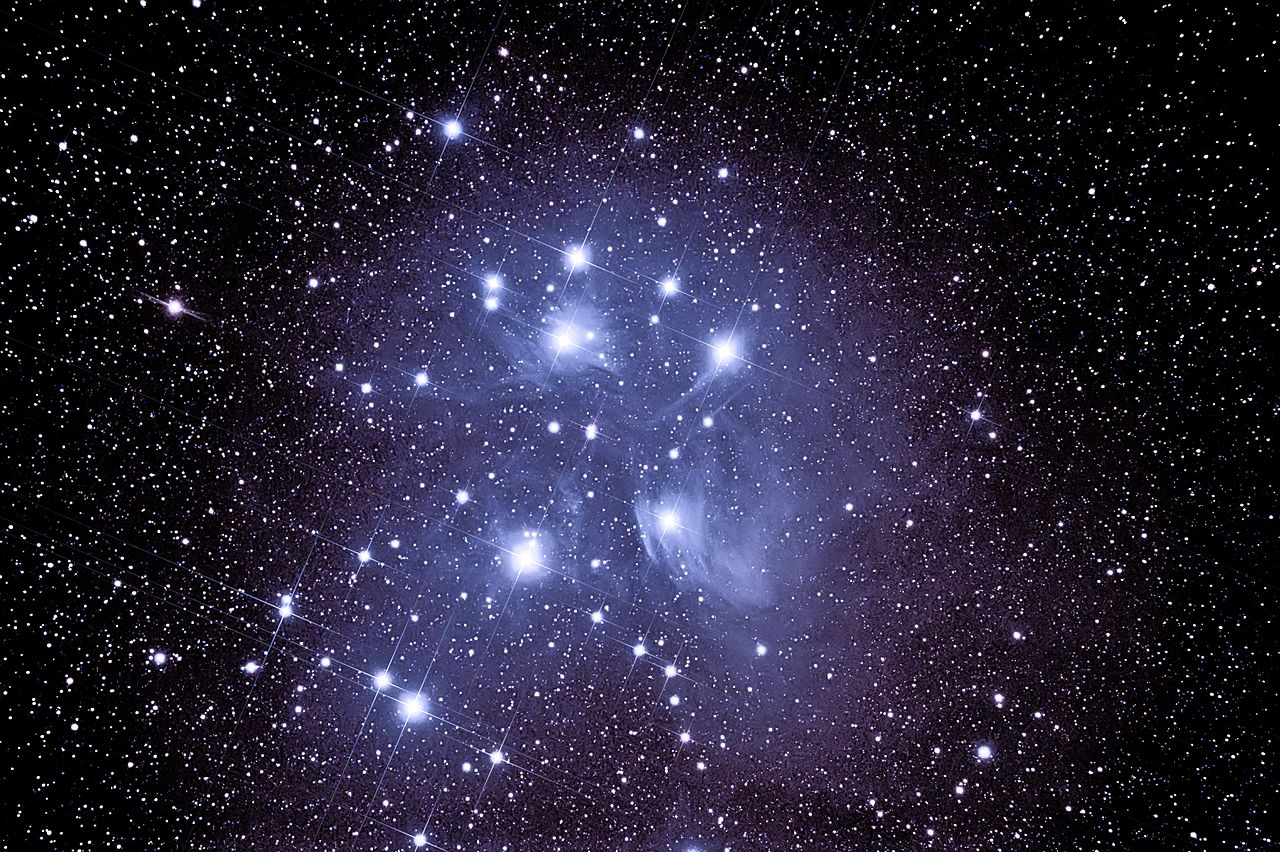
Charles Messier catalogued the Pleiades as Messier 45 on March 4, 1769, describing the object simply as a “cluster of stars, known by the name of the Pleiades. The position reported is that of the star Alcyone.”
In 1767, John Michell, English clergyman and philosopher, proposed that the stars in the cluster had to be physically related because the likelihood of a chance alignment of so many bright stars was 1 in 500,000. His theory was confirmed later, when scientists began to study the stars’ proper motions and discovered that they were all travelling in the same direction and at the same rate. Michell is also known for being the first person to propose the existence of objects whose gravitational fields are too strong for light to escape, also known as black holes.
In 1782, French astronomer Edme-Sébastien Jeaurat drew a map of 64 stars of M45 based on his observations of the cluster. The map was published in 1786.
Admiral William Henry Smyth wrote extensively about the individual stars in the Pleiades cluster and the observation history. Among other things, he noted:
The Pleiades constitute a celebrated group of stars, or miniature constellation, on the shoulders of Taurus; their popular influences have been said and sung for many years. Hesiod mentions them as the Seven Virgins, “of Atlas born;” and in the ancient M.S. of Cicero’s Aratus, in the British Museum, they are finely represented by female heads, inscribed Merope, Alcyone, Celaeno, Electra, Taygeta, Asterope, and Maia, under the general title Atlantides, – while the illustrations to Julius Firmicius in 1497, represents them as well-grown women. The moral may be, that Atlas himself first rigidly observed these stars, and named them after his daughters. But various are the appellations under which they have been known. Theon liked them to a bunch of grapes; Aratos says they were called Eptaporoi; Manilius clusters them as glomerabile sidus; the Arabs said they were Ath-thurayya, or the little ones; the French designate them as poussinière; the Germans, gluckhenne, the Italians knew them as le gallinelle; the Spaniards term them the cabrillas, or little manny-goats, which is the key of the Duke’s query to sancho; and several schools called them brood-hen, under the representation of a hen with chickens. There has also been much discussion as to the number of the individuals in the group, some of the ancients having advanced that there were seven, and others resolving to count six, in the spirit of Ovid’s oft-cited
Quae septem dici, sex tamen esse solent.
The “lost Pleiad” is however, rather a poetical than an exact expression, for in moonless nights I never had any difficulty in counting seven stars in the so-called Hexastron, with the naked eye; and indeed this is nothing to boast of, for many people may enumerate even more, though few will equal with Maestlinus, the discoverer of the new star of 1604, who, as Kepler avers, could distinctly see fourteen stars in the Pleiades, without any glasses. Still, if we admit the influence of variability at long periods, the seven in number may have occasionally been more distinct; so that while Homer and Attalus speak of six of them, Hipparchus and Aratus may properly mention seven. But they have a singular brilliant light for their magnitudes, whence the unassisted eye becomes dazzled.
John Herschel did not add the Pleiades to the General Catalogue, but did list Tempel’s Nebula, the reflection nebula around the star Merope, as GC 768, describing it as “magnificent, bright; very large; irregular figure; variable.”
MYTH
The Pleiades have been known to cultures around the world since pre-historic times. The cluster was mentioned in the works of Homer (Iliad and Odyssey, 750 B.C. and 720 B.C.), the prophet Amos (750 B.C.) and Hesiod (700 B.C.) among others.
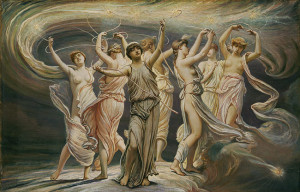
In Greek mythology, the cluster represents the Seven Sisters, companions of the goddess Artemis and daughters of the sea-nymph Pleione and the Titan Atlas, who held the celestial spheres on his shoulders. There are several different myths that tell the story of how the sisters became stars. In one, once their father was forced to carry the heavens, the hunter Orion started to pursue the sisters. To comfort Atlas, Zeus first transformed them into doves and then into stars. It is said that Orion can still be seen pursuing them across the sky.
In another tale, the Pleiades were saddened either by their father’s fate or by the loss of their sisters, the Hyades. Their grief drove them to commit suicide, and Zeus placed the sisters in the sky to immortalize them.
The Greeks oriented two famous temples on the Acropolis of Athens – Hekatompedon (550 B.C.) and Parthenon (438 B.C.) – to the rising of the Pleiades.
The cluster’s rising before dawn in early June has long been considered as the beginning of the new year by the Māori in New Zealand, where the Pleiades are known as Matariki and their rising is celebrated at a midwinter festival.
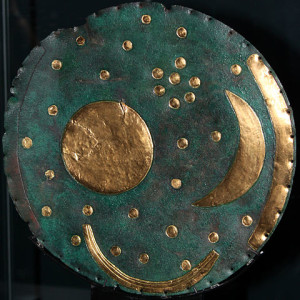
The earliest depiction of M45 was found on a bronze age artifact dating back to 1,600 B.C. The artifact is called the Nebra sky disk and it was discovered near Nebra in Germany.
The cluster is mentioned as Khima in the Bible three times: Amos 5:8, Job 9:9, and Job 38:31.
Persians knew the cluster as Soraya and its Japanese name is Subaru, which means “coming together” or cluster. The Vikings saw the Pleiades as Freya’s hens, while the Celts associated the stars with mourning because they rose in the eastern sky in the evening around the winter solstice, which coincided with a festival devoted to the remembrance of the dead.
In Arabic, M45 is known as al-Thurayya and mentioned in a number of ancient texts.
Babylonian astronomers new the Pleiades as MUL.MUL, “star of stars.” In Babylonian star catalogues, the Pleiades head the list of stars seen along the ecliptic as they were located near the vernal equinox in the 23rd century B.C.
In Hinduism, the cluster is known as Krittika, referring to the six sisters who raised the war god Kartikeya. The Chinese know M45 as the Hairy Head of the White Tiger of the West.
Native American cultures used the cluster to measure keenness of vision by the number of stars the observer could see it in. The Aztecs based their calendar on the Pleiades, with the cluster’s heliacal rising marking the beginning of the year. A number of other indigenous peoples of the Americas associated the Pleiades with various myths and legends.
STARS
The brightest stars in the Pleiades cluster are Alcyone (apparent magnitude 2.86), Atlas (3.62), Electra (3.70), Maia (3.86), Merope (4.17), Taygeta (4.29), the variable star Pleione (5.09), Celaeno (5.44), and Asterope (5.64, 6.41). The nine brightest stars are all luminous, hot, blue B-type stars.
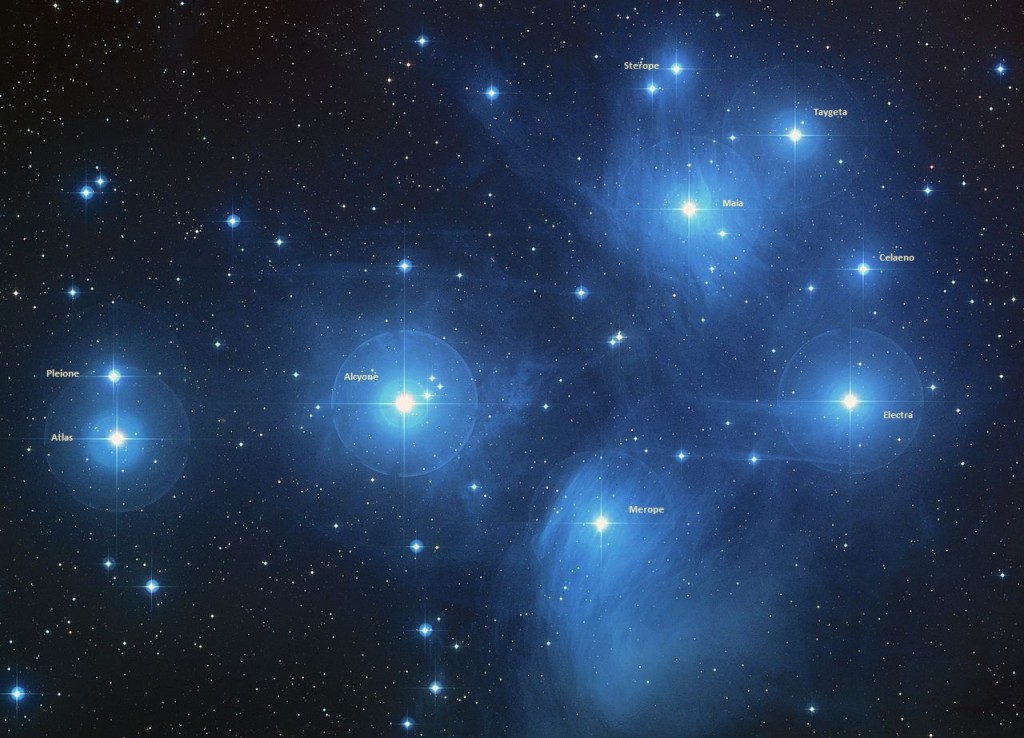
| Alcyone | Eta Tauri (25 Tauri) | B7IIIe | 2.86 |
| Atlas | 27 Tauri | B8III | 3.62 |
| Electra | 17 Tauri | B6IIIe | 3.70 |
| Maia | 20 Tauri | B7III | 3.86 |
| Merope | 23 Tauri | B6IVev | 4.17 |
| Taygeta | 19 Tauri | B6V | 4.29 |
| Pleione | BU Tauri (28 Tauri) | B8IVpe | 5.09 |
| Celaeno | 16 Tauri | B7IV | 5.44 |
| Sterope (Asterope) | 21 Tauri, 22 Tauri | B8Ve, B9V | 5.64, 6.41 |
Alcyone is an eclipsing binary system. The primary component is a a blue-white giant 8.2 times larger than the Sun, six times more massive, and 2,400 times more luminous.
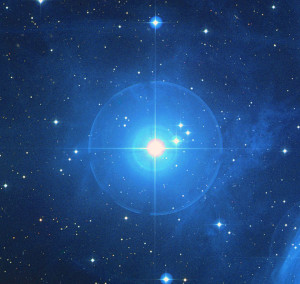
The star has a very high rotational velocity, 215 km/s, and as a result it has a circumstellar disk of gas around the equator. The second component is separated from the primary by 0.031 arc seconds, which is roughly equal to the distance between the Sun and Jupiter.
The binary system is orbited by three companions: two 8th magnitude A-type white dwarfs at a separation of 117 and 181 arc seconds, and a yellow F-type dwarf separated from the primary by 191 arc seconds.
Atlas is a triple star system consisting of a spectroscopic binary star with an orbital period of 1,250 days. The two components – a blue white giant with a visual magnitude of 4.1 and a companion with a magnitude of 5.6 – have a combined apparent magnitude of 3.62. The binary system has a fainter, magnitude 6.8 companion located at a separation of 0.4 seconds of arc.
Electra is another blue-white giant in the group. The star is also a rapid spinner, with a projected rotational velocity of 181 km/s at the equator. As a result, Electra is flattened at the poles and does not have a uniform surface gravity or temperature. This is an example of an effect known as gravity darkening. It occurs as a result of a variation of radiation by latitude.
Maia, the fourth brightest star in the cluster, is a blue giant and a mercury-manganese star, a chemically peculiar star with a strong spectral line at 398.4, resulting from absorption from ionized mercury. The star is 850 times more luminous than the Sun, six times as a large and over five times as massive. Maia is the central star of the Maia Nebula, a bright reflection nebula in the Pleiades cluster.
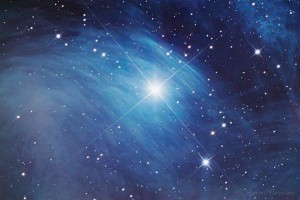
Merope is another Pleiad associated with a reflection nebula. The blue subgiant is surrounded by the Merope Nebula, a diffuse reflection nebula the M45 cluster is currently passing through. The star is 630 times more luminous than the Sun and has a mass about 4.5 times solar. Merope’s radius is more than four times greater than the Sun’s.
Taygeta is another multiple star system in the cluster. The triple star has a blue-white subgiant for a primary component. The star is a spectroscopic binary consisting of two stars with visual magnitudes of 4.6 and 6.1, separated by 0.012 arc seconds. The two stars complete an orbit every 1,313 days. They have an 8th magnitude companion separated by 69 arc seconds.
Pleione is another hot B-type star in the cluster. It is 190 times more luminous than the Sun and spins close to its breakup velocity, at 329 km/s. The star is located less than 5 arc minutes away from the considerably brighter Atlas and is not easily visible to the naked eye. It is classified as a Gamma Cassiopeiae-type variable. Its brightness varies from magnitude 4.8 to 5.5 and it has the variable star designation BU Tauri. Because the star rotates so rapidly, it has a circumstellar disk of ejected material orbiting it.
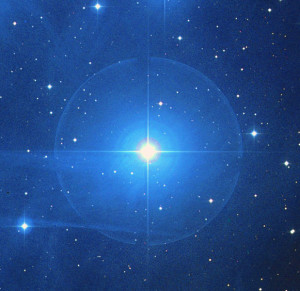
With a radius 3.2 times solar and a mass 3.4 times solar, Pleione is significantly smaller than the other bright stars in the cluster.
It is a main sequence dwarf with a surface temperature of 12,000 K.
Celaeno is another B-type blue subgiant star in M45. It is 4.4 times larger than the Sun and 9 to 10 times more massive.
The star is another rapid spinner, with a projected rotational velocity of 185 km/s.
The name Sterope (or Asterope) is shared by 21 Tauri and 22 Tauri, two stars separated by 0.047 degrees on the sky.
21 Tauri is a blue B-type main sequence star with a visual magnitude of 5.76 and 22 Tauri is a white main sequence dwarf with a magnitude of 6.43.
LOCATION
How to find the Pleiades
The Pleiades cluster is very easy to find. It is located about 14 degrees northwest of Aldebaran, the brightest star in Taurus and 14th brightest star in the night sky.
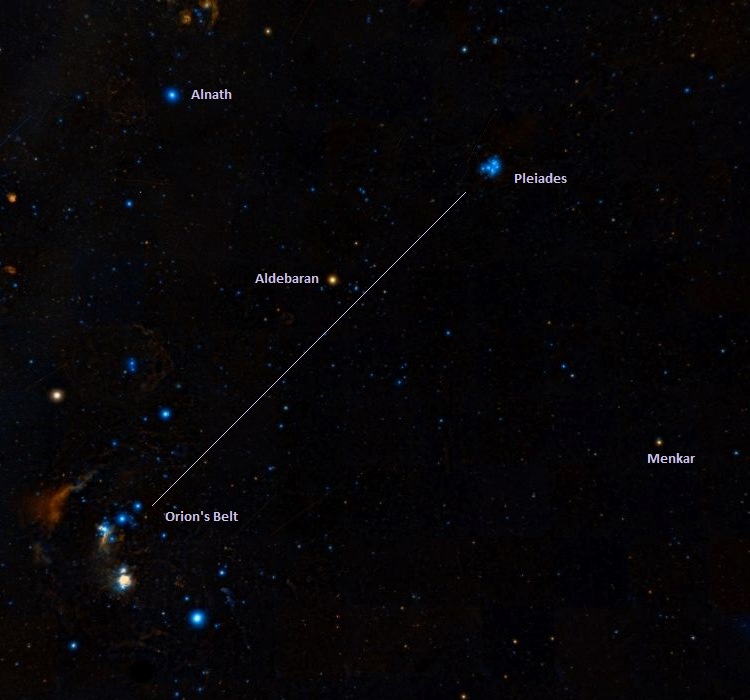
When the cluster is high in the sky, it can be located by following the line formed by the three bright stars that form Orion’s Belt: Alnilam, Alnitak and Mintaka. M45 lies to the northwest of the celestial Hunter.
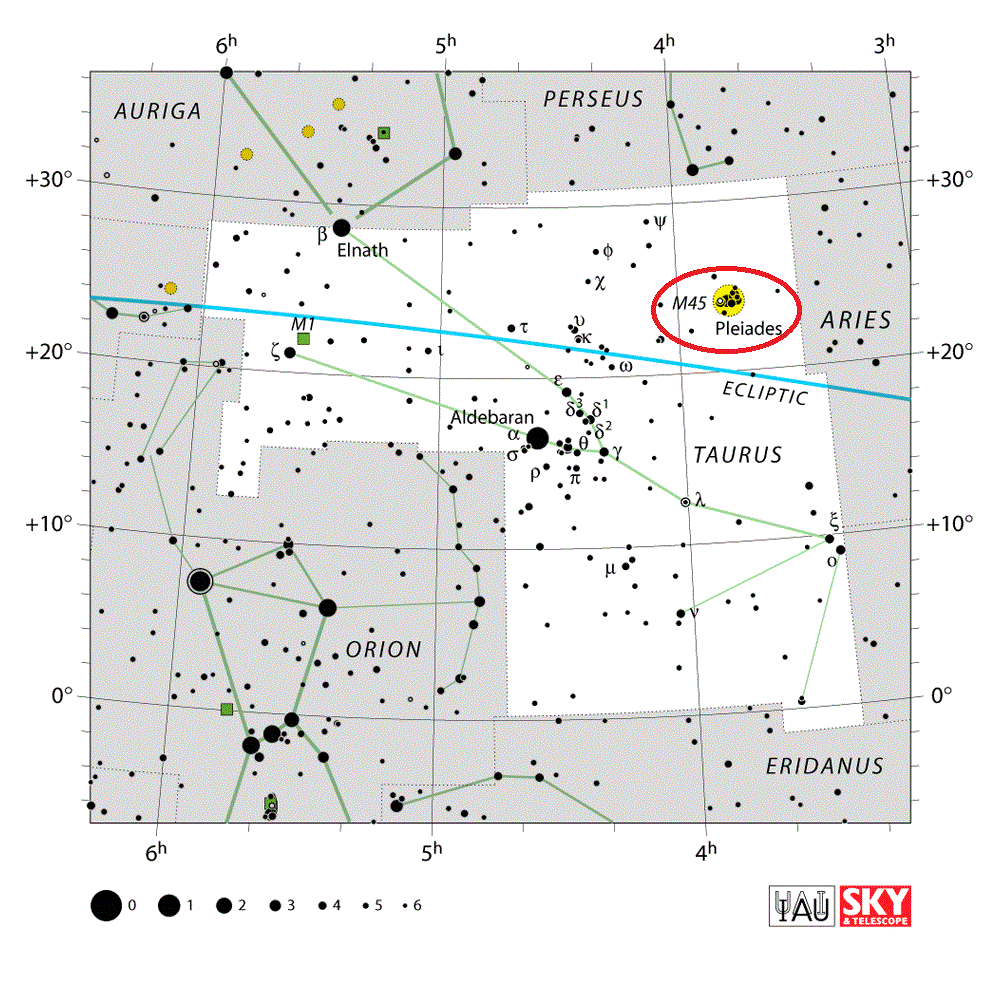
FACTS
| Object: Cluster |
| Type: Open |
| Designations: Messier 45, M45, Pleiades, Seven Sisters, Subaru, Collinder 42, Melotte 22, C 0344+239, OCl 421.0, H 0346+24, MWSC 0305 |
| Features: Maia Nebula, Merope Nebula |
| Constellation: Taurus |
| Right ascension: 03h 47m 24s |
| Declination: +24°07′ |
| Distance: 444 light years (136.2 parsecs) |
| Age: 115 million years |
| Number of stars: >1,000 |
| Apparent magnitude: +1.6 |
| Apparent dimensions: 110′ |
| Radius: 8 light years |
| Tidal radius: 43 light years |
IMAGES
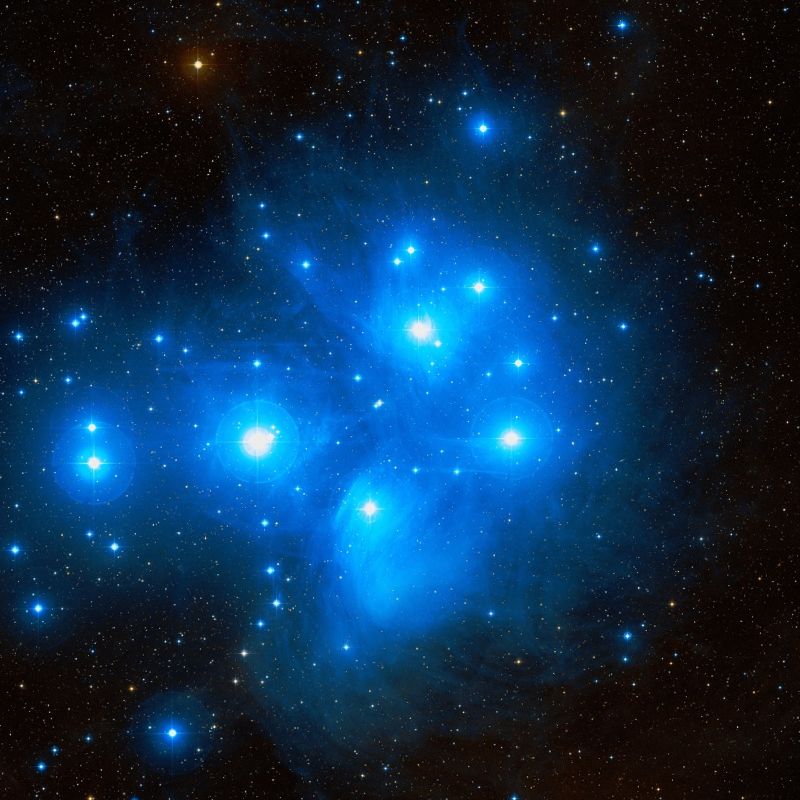
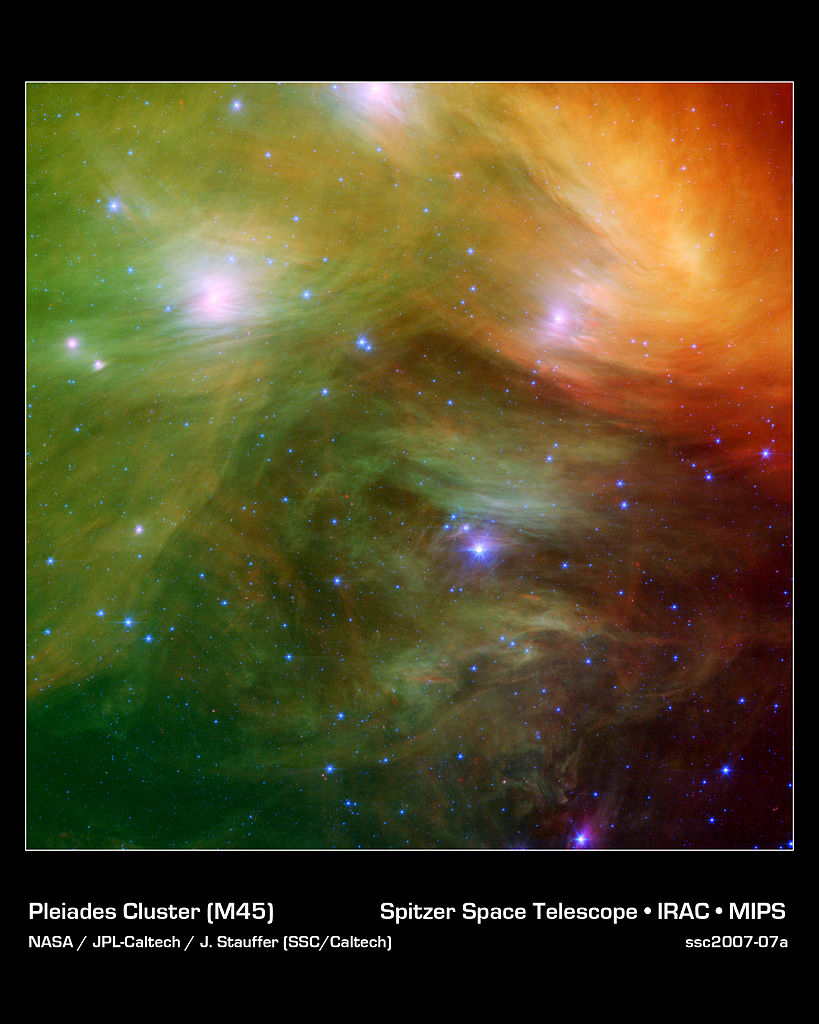
The star cluster was born when dinosaurs still roamed the Earth, about one hundred million years ago. It is significantly younger than our 5-billion-year-old sun. The brightest members of the cluster, also the highest-mass stars, are known in Greek mythology as two parents, Atlas and Pleione, and their seven daughters, Alcyone, Electra, Maia, Merope, Taygeta, Celaeno and Asterope. There are thousands of additional lower-mass members, including many stars like our sun. Some scientists believe that our sun grew up in a crowded region like the Pleiades, before migrating to its present, more isolated home. The new infrared image from Spitzer highlights the “tangled silver braid” mentioned in the poem by Tennyson. This spider-web like network of filaments, colored yellow, green and red in this view, is made up of dust associated with the cloud through which the cluster is traveling. The densest portion of the cloud appears in yellow and red, and the more diffuse outskirts appear in green hues. One of the parent stars, Atlas, can be seen at the bottom, while six of the sisters are visible at top. Image: NASA/JPL-Caltech/J. Stauffer (SSC/Caltech), April 2007.
